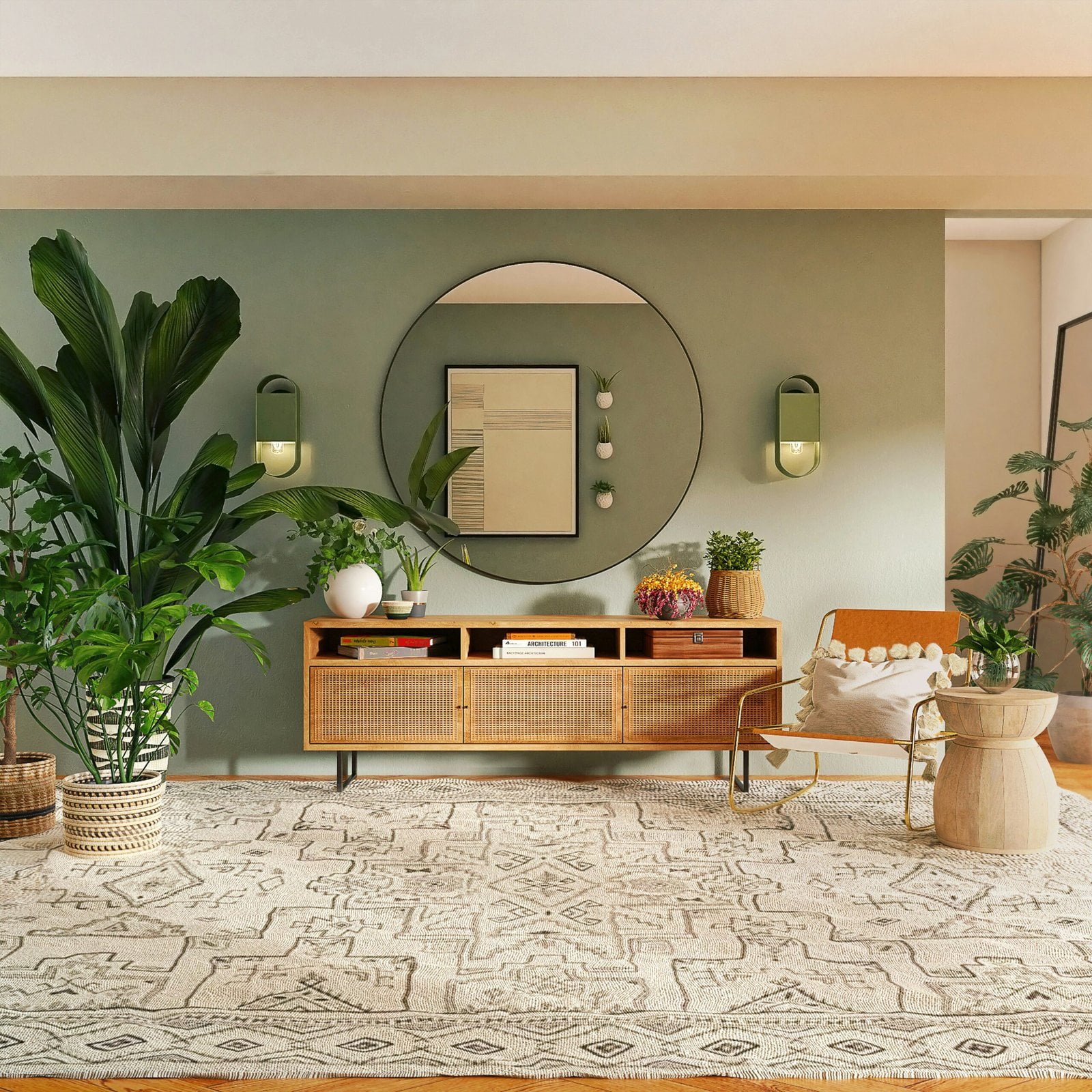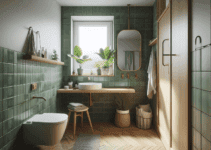Learn how to enhance the coziness and functionality of your open-plan living dining area by defining distinct zones with area rugs, strategic furniture arrangement, and appropriate lighting. Discover how warm and inviting colors, textures, and layers can transform your space into a welcoming and intimate environment. Personalize your decor with family photos, travel souvenirs, plants, and candles to create a unique and cozy atmosphere that reflects your personality.
Define Distinct Zones
Creating distinct zones within an open-plan layout is essential for enhancing coziness and functionality in your living dining area. By effectively delineating spaces, you can maintain an open feel while ensuring each area has its own identity. One of the most effective ways to define zones is through the use of area rugs. Selecting the right size and style of rugs can visually separate the living and dining areas, adding warmth and character to each space. When choosing a rug, consider the dimensions of your furniture and ensure it complements the overall decor style.

Furniture arrangement also plays a crucial role in creating a natural flow between zones. Strategically placing furniture can create visual boundaries without the need for physical barriers. For instance, positioning a sofa with its back to the dining area can clearly distinguish the living space. Similarly, arranging dining furniture in a way that it faces away from the living zone can help in defining the dining area. Ensure there is a cohesive flow between the zones to maintain balance and continuity throughout the space.
Please read our article watch the newly uploaded video from our YouTube channel:
“Grig Stamate – Interior Design Solutions”
https://www.youtube.com/@GrigStamate
How to Create COZINESS in Your LIVING/DINING AREA (open plan layout) (video)
Here, you can see other related videos from our channel:
How to Create COZINESS in Your LIVING ROOM (fireplace not required) (video)
Cozy Small Living Room Design [Tips and Tricks] (video)
Lighting is another powerful tool in delineating distinct zones. Using different lighting fixtures for each area can highlight and enhance the individuality of each space. For the living area, consider using ambient lighting such as floor lamps or wall sconces to create a cozy atmosphere. In contrast, pendant lights or a chandelier over the dining table can draw attention to the dining area, making it a focal point. Dimmer switches can also be an excellent addition, allowing you to adjust the lighting intensity to suit different moods and activities.
Ultimately, the key to achieving coziness in an open-plan layout lies in the balance between maintaining an open feel and ensuring each zone has its own distinct identity. By thoughtfully selecting area rugs, arranging furniture for natural flow, and using appropriate lighting, you can create a harmonious and inviting living dining area that is both functional and aesthetically pleasing.
Incorporate Warm and Inviting Colors
Color choices play a pivotal role in establishing the coziness of an open-plan living dining area. The right hues can transform a stark, expansive space into an inviting and intimate environment. To achieve this, consider integrating warm, neutral, and earthy tones into your design palette. These colors not only create a welcoming ambiance but also evoke a sense of comfort and relaxation.
Warm colors, such as shades of beige, taupe, and cream, can make a large area feel more intimate by visually contracting the space. These tones act as a neutral canvas that harmonizes with various decor styles and elements. Earthy hues like terracotta, ochre, and olive green bring a touch of nature indoors, enhancing the feeling of warmth and grounding the overall aesthetic.
The psychological effects of color are well-documented. For instance, warm tones like reds and oranges can stimulate conversation and appetite, making them ideal for dining areas. Conversely, softer shades like muted greens and blues can promote relaxation, making them suitable for living spaces where unwinding is the goal. By understanding these effects, you can strategically use color to influence the mood of your open-plan layout.
To introduce these colors without overwhelming the space, consider using accent walls. A single wall painted in a warm hue can add depth and dimension without dominating the room. Additionally, incorporating cushions, throws, and artwork in complementary colors can infuse warmth and personality into the space. These elements are not only functional but also offer an easy way to update the look seasonally or as trends evolve.
Ultimately, the key to creating coziness lies in the balanced use of inviting colors. By thoughtfully selecting and distributing warm, neutral, and earthy tones, you can transform your open-plan living dining area into a sanctuary of comfort and style.
Use Textures and Layers
Creating coziness in an open-plan living dining area can be achieved effectively through the strategic use of textures and layers. By incorporating a variety of textures, you can add both depth and comfort to the space, transforming it into a warm and inviting environment. Textiles such as cushions, throws, and curtains play a pivotal role in this regard. For instance, plush cushions on a sofa can offer a soft, tactile experience, while a knitted throw draped over a chair introduces a sense of warmth and homeliness.
Beyond textiles, the inclusion of materials like wood, metal, and glass can further enhance the tactile appeal of your living dining area. A wooden coffee table or dining table can introduce natural warmth and an organic feel, while metal accents, such as a sleek floor lamp or a decorative bowl, provide a modern edge and contrast. Glass elements, like a vase or a glass-top table, can add a touch of elegance and lightness to the room.
Layering these elements is key to creating a visually interesting and cozy environment. For example, mix a wool rug with a leather armchair, or combine a velvet sofa with a glass coffee table. Such combinations not only add visual interest but also make the space feel more intimate and inviting. By layering different textures and materials, you can create a dynamic interplay that appeals to the senses and enhances the overall coziness of the area.
Moreover, consider the interplay of textures within your color scheme. A monochromatic palette can be elevated by introducing various textures, preventing the space from feeling flat. For instance, a grey room can be brought to life with a mix of velvet cushions, a shaggy rug, and linen curtains. These elements work together to create a rich, layered look that is both aesthetically pleasing and comfort-inducing.
In summary, the thoughtful use of textures and layers can significantly enhance the coziness of an open-plan living dining area. By blending different textiles and materials, and creatively layering them, you can craft a space that is not only visually appealing but also inviting and comfortable.
Personalize with Decor and Accessories
Personal touches play a pivotal role in transforming an open-plan living dining area into a cozy and unique space. Integrating personal decor elements such as family photos, travel souvenirs, and cherished collectibles not only adds character but also tells a story about the inhabitants of the home. For instance, creating a gallery wall with a mix of family portraits and artworks can serve as a focal point, fostering a sense of intimacy and warmth.
Travel souvenirs and cherished collectibles, when thoughtfully displayed, can evoke fond memories and spark conversations. Consider placing these items on open shelves or in a dedicated display cabinet, ensuring they are arranged in a visually appealing manner. Grouping items by theme, color, or material can create a cohesive look while avoiding the appearance of clutter.
Incorporating plants into the living dining area is another effective way to enhance coziness. Houseplants not only add a touch of nature but also improve air quality and bring life to the space. Choose a variety of plants with different textures and sizes to create visual interest. Placing potted plants on shelves, side tables, or even hanging them from the ceiling can help in distributing greenery throughout the area.
Candles are a timeless accessory that can instantly add warmth and a sense of tranquility. Strategically placing candles on dining tables, coffee tables, or mantels can create a soothing ambiance, especially in the evenings. Opt for candles in varying heights and colors to add depth and dimension to the decor.
While personalizing the space, it is crucial to strike a balance between personalization and clutter. Too many items can overwhelm the space and detract from its cozy atmosphere. To display items thoughtfully, consider using trays, baskets, and decorative boxes to contain smaller items and keep surfaces organized. Rotating decor elements seasonally can also keep the space feeling fresh and inviting.
Ultimately, the goal is to create a living dining area that reflects your personality and feels like home. By carefully selecting and arranging personal decor and accessories, you can achieve a harmonious and cozy environment that is both functional and aesthetically pleasing.
Other related posts from our website:
Let’s see here, three of them:
https://howtobuildahouseblog.com/how-to-create-coziness-in-your-living-room-fireplace-not-required/
https://howtobuildahouseblog.com/cottage-core-embracing-simplicity-and-coziness-as-a-lifestyle/
https://howtobuildahouseblog.com/textiles-create-coziness-and-warmth-in-the-living-room/
We also sincerely hope you like our ideas from this post, and you have also enjoyed our uploaded YouTube video.
See you next time at another article.
Thank you so much for your time. Bye now!



No Responses